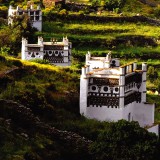This research studies the unique architectural perspective of the dovecotes under the geographical context of the Greek island, Tinos. These were richly decorated structures that are not simply pigeon shelters but emblematic elements of cultural heritage. More specifically, a detailed analysis of the construction materials, the symbolism and the geometry of the stone decorations of their facade and of the wider folk architecture is presented.
Also of utmost importance is the symbiotic relationship between humans and pigeons, since it effectively contributes to the circular economy and ecological balance. The bioclimatic principles inherent in the design of the pigeon houses are also examined, highlighting how they withstand the island's climatic challenges. Also, the possible resurgence of pigeon breeding is presented as a means to strengthen the paradisiacal agricultural practice and to further strengthen the island's economy, beyond the tourist contribution it has.
Also, there is a discussion about the historical and cultural importance of such architectural constructions, emphasizing their ability to offer their use again in different ways, ultimately leading to sustainable development of the area in which they exist. In conclusion, the study offers the burning need for the protection of these architectural structures which are characterized, in the current period, as neglected and dilapidated.
